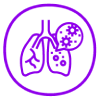- Article
- Source: Campus Sanofi
- May 20, 2025
European Respiratory Society (ERS)/ European Society for Blood and Marrow Transplantation (EBMT) clinical practice guidelines on treatment of pulmonary cGvHD in adults
_430x268.jpg)
KEY TAKEAWAY
The ERS/EBMT task force developed evidence-based recommendations for the treatment of pulmonary cGvHD-BOS in adults. This clinical guideline aimed to assist HCPs in optimizing pulmonary cGvHD care to promote safe and effective treatment and to improve quality of care for patients.
.png)
The guideline addresses common therapeutic options (inhalation therapy, fluticasone, azithromycin and/or montelukast, imatinib, ibrutinib, ruxolitinib, belumosudil, extracorporeal photopheresis, and lung transplantation) and aspects of general management (lung functional and radiological follow-up, and pulmonary rehabilitation)
.png)
Recommendations include key advancements for incorporation in managing adults with pulmonary cGvHD-BOS and are aimed at improving and standardizing treatment and improving outcomes; however,
- Individual values, preferences, perceptions, and clinical circumstances should be considered while interpreting all recommendations
%20(1).png)
Importantly, it is crucial that these drugs be prescribed by physicians who have expertise in their use and potential AEs
WHY THIS MATTERS
.png)
cGvHD frequently causes late-onset noninfectious complications in the lung after alloHSCT, which develops in ~20% of patients, usually within the first two years after transplant
.png)
The most common late pulmonary complication is the obstructive phenotype BOS, which is presently the only entity formally recognized as a pulmonary cGvHD manifestation
.png)
No standardized or harmonized approach is available for the optimal management of patients with pulmonary cGvHD
- Additionally, little is known about the impact of newer, recently approved agents for cGvHD treatment, particularly on BOS
.png)
Hence, the ERS/EBMT task force developed evidence-based recommendations for the treatment of pulmonary cGvHD-BOS in adults targeting treatment, lung functional and radiological follow-up, and supportive treatment
KEY HIGHLIGHTS
.png)
A multidisciplinary group including specialists in hematology, respiratory medicine and methodology, and patient advocates, formulated eight patient, intervention, comparison, outcome (PICO), and two narrative questions
.png)
Systematic reviews were conducted to address these questions and the Grading of Recommendations Assessment, Development and Evaluation approach was used to develop recommendations following the ERS standardized methodology
SUMMARY OF PICO QUESTIONS AND RECOMMENDATIONS
| Title | Recommendations | Considerations |
| Q1. In adults with lung cGvHD-BOS, should ICS ± LABA be used in addition to their conventional immunosuppressive regimen? | Suggest using ICS ± LABA in addition to their conventional immunosuppressive regimena |
|
| Q2. In adults with lung cGvHD-BOS, should FAM be used in addition to conventional immunosuppressive regimen? | Suggest using FAM in addition to their conventional immunosuppressive regimenb |
|
| Q3. In adults with lung cGvHD-BOS, should imatinib be used in addition to their conventional immunosuppressive regimen? | Suggest either imatinib in addition to their conventional immunosuppressive regimen or conventional immunosuppressionc |
|
| Q4. In adults with lung cGvHD-BOS, should ibrutinib be used in addition to their conventional immunosuppressive regimen? | Suggest not using ibrutinib in addition to their conventional immunosuppressive regimenb |
|
| Q5. In adults with lung cGvHD-BOS, should ruxolitinib be used in addition to their conventional immunosuppressive regimen? | Suggest either ruxolitinib in addition to their conventional immunosuppressive regimen or conventional immunosuppressionc |
|
| Q6. In adults with lung cGvHD-BOS, should belumosudil be used in addition to their conventional immunosuppressive regimen? | Suggest either belumosudil in addition to their conventional immunosuppressive regimen or conventional immunosuppressionc |
|
| Q7. In adults with lung cGvHD-BOS, should ECP be used in addition to their conventional immunosuppressive regimen? | In adults with progressive lung cGvHD-BOS, suggest using ECP in addition to their conventional immunosuppressive regimenb |
|
| Q8. In adults with endstage lung cGvHDBOS, should lung transplantation be performed? | In highly selected adults with endstage lung cGvHDBOS, we suggest lung transplantation as a life-saving therapeutic optionb |
|
BOS, bronchiolitis obliterans syndrome; cGvHD, chronic graft-versus-host disease; CLL, chronic lymphocytic leukemia; CML, chronic myeloid leukemia; CYP3A, cytochrome P450 3A; ECP, extracorporeal photopheresis; FAM, fluticasone, azithromycin, and/or montelukast; GI, gastrointestinal; GvHD, graft-versus-host disease; ICS, inhaled corticosteroids; LABA, long-acting β-agonist; PICO, patient, intervention, comparison, outcome.
aConditional recommendation, low certainty of evidence.
bConditional recommendation, very low certainty of evidence.
cConditional recommendation for either intervention or comparison, very low certainty of evidence.
| Title | Recommendations | Considerations |
|
Q1. How and how frequently should adults with lung cGvHD -BOS be re-evaluated?
|
|
|
| Q2. Should attention be paid to other interventions in adults with lung cGvHD-BOS: flu,pneumococcal and COVID -19 vaccination, infection prophylaxis, including Ig, pulmonary rehabilitation, smoking cessation, longterm oxygen treatment? |
|
|
alloHSCT, allogeneic hematopoietic stem cell transplantation; BOS, bronchiolitis obliterans syndrome; cGvHD, chronic graft-versus-host disease; COPD, chronic obstructive pulmonary disease; COVID-19, coronavirus disease 2019; CT, computed tomography; FEV1, forced expiratory volume in 1 s; GvHD, graft-versus-host disease; Ig, immunoglobulins; IgG, immunoglobulin G; PFT, pulmonary function test.
Conditional recommendation, very low quality of evidence stemming from narrative review of evidence.
KEY LIMITATIONS
%20(1).png)
- BOS-specific studies are rare; most included studies were retrospective in nature and involved a small number of patients with BOS per study
- Timing of treatment administration for BOS was likely to be heterogeneous, e.g., treatment with early-phase vs established late-phase disease, which could have affected treatment efficacy
- Across studies, study protocols, treatment doses, conventional immunosuppression, transplant-related drugs, and lines of treatment differed
- Comparisons between studies were very challenging, as endpoints often varied and some studies used combined endpoints (i.e., ORR based on symptoms and PFT data)
Please refer to the source publication Bos S, et al. for additional details.
ABBREVIATIONS
AEs, adverse events; alloHSCT, allogeneic hematopoietic stem cell transplantation; BOS, bronchiolitis obliterans syndrome; cGvHD, chronic graft-versus-host disease; ERS, European Respiratory Society; EBMT, European Society for Blood and Marrow Transplantation; ORR, overall response rate; PICO, patient, intervention, comparison, outcome; PFT, pulmonary function test.
Bos S, Murray J, Marchetti M, Cheng GS, Bergeron A, Wolff D, et al. ERS/EBMT clinical practice guidelines on treatment of pulmonary chronic graft-versus-host disease in adults. Eur Respir J. 2024;63(3):2301727. doi: 10.1183/13993003.01727- 2023. PMID: 38485149.
MAT-KW-2400454/V1/Dec2024